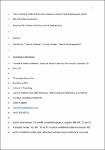Content of nitrate and nitrite in commercial and self-made beetroot juices and the effect of storage temperature
| dc.contributor.author | Bescos Garcia, Raul | |
| dc.contributor.author | Rollason, ML | |
| dc.contributor.author | Davies, TS | |
| dc.contributor.author | Casas-Agustench, P | |
| dc.date.accessioned | 2023-07-24T11:09:46Z | |
| dc.date.available | 2023-07-24T11:09:46Z | |
| dc.date.issued | 2023-07-23 | |
| dc.identifier.issn | 2048-7177 | |
| dc.identifier.issn | 2048-7177 | |
| dc.identifier.uri | https://pearl.plymouth.ac.uk/handle/10026.1/21064 | |
| dc.description | File replaced (docx to pdf) on 25.7.23 by NK (LDS) | |
| dc.description.abstract |
Popularity of beetroot juice (BJ) is growing due to its high inorganic nitrate content (NO₃) and its potential physiological benefits. However, the content of NO₃ is not indicated in most commercial BJs and it can be affected by seasonal changes and storage conditions. This study analyzed the content of NO₃ and nitrite (NO₂) in five and two commercial and self-made BJs, respectively, that were purchased in the summer and winter periods. The effect of storage temperature (20°C, 4°C, and −20°C) and pH was also analyzed. In nonconcentrated BJs, the NO₃ content was 34 ± 20% (p = .075) in the winter than in the summer. NO₃ was fully degraded in self-made BJ after 3 days at 20°C. This effect was attenuated by 78% and 82% when it was kept at 4°C and −20°C, respectively. The addition of lemon juice (5%) to self-made BJ was another useful approach to avoid NO₃ degradation for 3 days when it was kept at 20°C. Regarding NO₂, self-made BJ had higher concentration (0.097 ± 0.01 mg/mL) compared to commercial BJs (<0.1 mg/mL; p = .001). The pH of self-made BJ was higher (6.3 ± 0.1) compared to commercial BJs (4.5 ± 0.3; p = .001). These results suggest that the content of NO₃ in nonconcentrated BJs can substantially differ across the year and this is an important factor to take into account when recommending BJs to promote some of its potential physiological benefits. | |
| dc.language | en | |
| dc.publisher | Wiley Open Access | |
| dc.subject | beet | |
| dc.subject | nitrate | |
| dc.subject | nitric oxide | |
| dc.subject | nitrite | |
| dc.subject | nitrogen | |
| dc.title | Content of nitrate and nitrite in commercial and self-made beetroot juices and the effect of storage temperature | |
| dc.type | journal-article | |
| dc.type | Journal Article | |
| plymouth.author-url | https://www.webofscience.com/api/gateway?GWVersion=2&SrcApp=PARTNER_APP&SrcAuth=LinksAMR&KeyUT=WOS:001034675400001&DestLinkType=FullRecord&DestApp=ALL_WOS&UsrCustomerID=11bb513d99f797142bcfeffcc58ea008 | |
| plymouth.publication-status | Published online | |
| plymouth.journal | Food Science and Nutrition | |
| dc.identifier.doi | 10.1002/fsn3.3575 | |
| plymouth.organisational-group | |Plymouth | |
| plymouth.organisational-group | |Plymouth|Research Groups | |
| plymouth.organisational-group | |Plymouth|Faculty of Health | |
| plymouth.organisational-group | |Plymouth|Faculty of Health|School of Health Professions | |
| plymouth.organisational-group | |Plymouth|Research Groups|Institute of Health and Community | |
| plymouth.organisational-group | |Plymouth|REF 2021 Researchers by UoA | |
| plymouth.organisational-group | |Plymouth|Users by role | |
| plymouth.organisational-group | |Plymouth|Users by role|Academics | |
| plymouth.organisational-group | |Plymouth|REF 2021 Researchers by UoA|UoA03 Allied Health Professions, Dentistry, Nursing and Pharmacy | |
| plymouth.organisational-group | |Plymouth|Research Groups|Plymouth Institute of Health and Care Research (PIHR) | |
| dcterms.dateAccepted | 2023-07-08 | |
| dc.date.updated | 2023-07-24T11:09:45Z | |
| dc.rights.embargodate | 2023-7-26 | |
| dc.identifier.eissn | 2048-7177 | |
| dc.rights.embargoperiod | forever | |
| rioxxterms.versionofrecord | 10.1002/fsn3.3575 |


